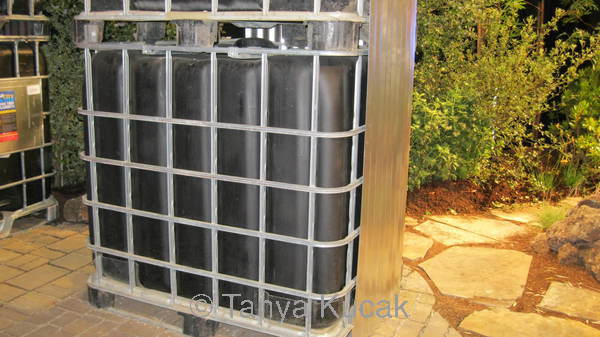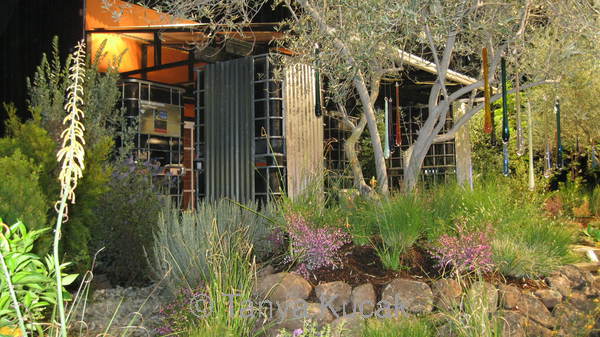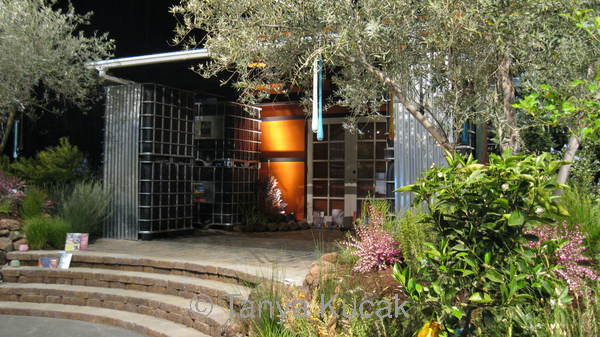
The holy grail is a lush landscape that needs no maintenance or watering and feeds you as well. That won't happen in the real world, because plants are alive and need care. But you can cut way back on imported water and still have an attractive and productive garden.
At this year's San Francisco Flower and Garden Show, a hydro literate landscape designed by Nathan Beeck and Chris Lopez of Clearwater Designs offered ideas for creating a productive, ecologically responsible landscape that uses no city water.
The most obvious part of the system is eight tanks that collect roof runoff. Each tank holds 280 gallons. These tanks, Beeck said, are recycled shipping containers that cost around $125 each and are light enough when empty for one person to roll around. Each tank comes with an access port in the top and a shutoff valve near the bottom, both with 2-inch pipe fittings.
Two tanks, stacked, fit comfortably under the eaves of a house. The patio in the show garden featured the tanks as pillars around a patio. When filled with water, the tanks collect heat during the day and radiate it back at night, Beeck said, which is an advantage on cool summer nights. You can spend more time on the patio without getting chilled.
Another way to set up the tanks is to stack two tanks under each rain gutter. A typical house has five rain gutters, so with ten tanks, you could store 2800 gallons of water, Beeck said. The wire grid that forms the structural exoskeleton of the tanks could be used as a trellis, he said, to grow vegetables.
Beneath the permeable pavers in the show garden was a 4500 gallon cistern. Rain falling on the patio, as well as overflow from the roof once the tanks are full, fills the cistern. A tank this size is expensive and requires more space, but it's worth considering as part of a patio or landscape renovation.
Even in a year with scant rainfall, Beeck said, the tanks and cistern could reach capacity with about 3 days of normal rainfall collected from the roof of a 2000 square foot house. The eight tanks in the show garden, plus the cistern, can store 6740 gallons of water. This can go a long way toward watering a well-mulched, well-designed landscape of drought-tolerant and edible plants, depending on the size of the garden, but it probably won't be enough to last until the rains resume.
To supplement the stored water, Beeck waters his seven fruit trees with a laundry-to-landscape system. Santa Clara Valley Water District (SCVWD) offers rebates for these easy-to-plumb systems. Greywater (sink and shower water) is another possibility to explore for watering trees and shrubs.
At Beeck's house, a pond that's used recreationally in the warmer months can be diverted to landscape watering from September to October, before the rains return. It holds 20 to 30 thousand gallons. With a biofilter, there's no risk of harming plants with treated pool water.
The show garden also featured a dry streambed to channel rainwater and keep it onsite, and a rain garden to take advantage of winter rain.

You can use the metal grid that encases this water storage tank as a trellis for climbing annual vegetables such as cucumbers or beans. Each tank can hold 280 gallons of rainwater.

A well mulched, well designed permaculture landscape includes both edible plants to feed you and drought-tolerant plants to provide year-round structure. Here, olive trees and bunchgrasses need far less water than a typical landscape.

The “no city water” display garden created by Clearwater Designs at the San Francisco Flower and Garden Show featured 8 large rainwater-storage tanks, used as patio walls, and a cistern below the patio. Altogether, the water storage capacity was 6740 gallons.
© 2014 Tanya Kucak